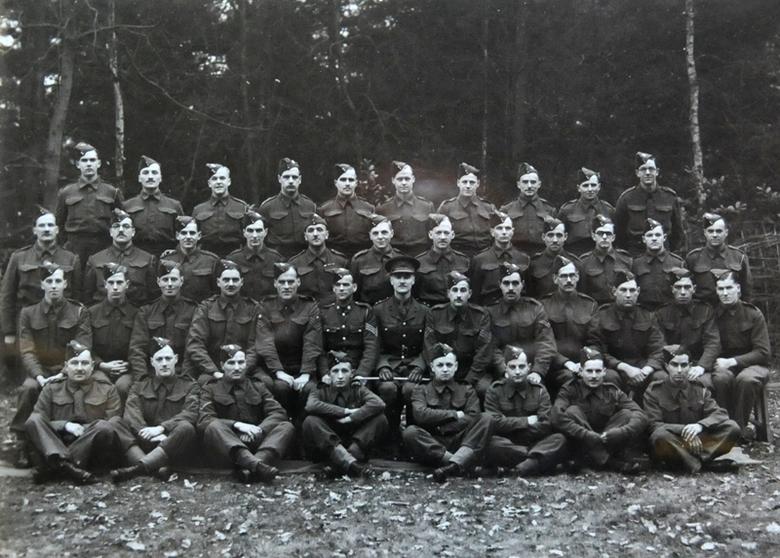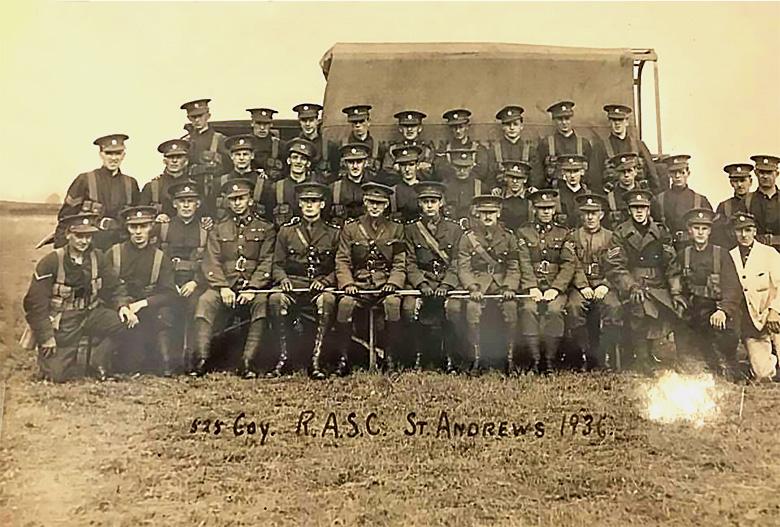The Royal Army Services Corps
525, 526 & 527 Comp.
The Royal Army Service Corps (RASC) was a corps of the British Army. It was responsible for land, coastal and lake transport; air despatch; supply of food, water, fuel, and general domestic stores such as clothing, furniture and stationery, administration of barracks; the Army Fire Service; and provision of staff clerks to headquarters units.

R.A.S.C., Officers Training
show infoDescription:
Thanks to James Gillies for sending us this photograph of the 51st Highland Division, R.A.S.C., Officers' Training Company taken in December 1939. The photo has been added to the Mobilisation section as it was possibly taken whilst the Division was at Aldershot, prior the eventual embarkation to Le Havre from Southampton in January 1940. A full list of those present in the lineup can be found here.
Credit:
James Gillies
High Resolution Image:
Tags:
THE ROLE OF THE RASC.
Military Training Pamphlet No23 Part 1.
The role of the Royal Army Service Corps in the field falls into two main parts, supply and transport.
Supply.
Supply embraces the provision of food, petrol and lubricants, fuel and light, hospital supplies and disinfectants.
Transport.
Transport is concerned with the conveyance of the above supplies, together with ammunition, engineer stores, ordnance stores and post, from railhead, or from base if no railhead exists, to all units of a field force.
In addition RASC units are provided for the carriage of infantry, tanks and heavy bridging equipment. The mechanical transport of medical and certain other units is also found and operated by the RASC.
To enable these services to be undertaken effectively, the RASC are responsible for the provision, repair, and maintenance of their own mechanical transport.
General Transport Companies are allotted to divisions for the transport of ammunition, supplies and petrol. Similar companies are allotted to higher formations and for employment in Line of Communication areas as required.
Personnel of the RASC are trained to fight as infantry and RASC units are responsible for their own local defence.
More detail can be found on the history of the Royal Army Service Corps at forces-war-records.co.uk
And at the Royal Logistics Corps Museum - The RLC Museum - The Royal Logistic Corps
THE RASC IN THE 51st HIGHLAND DIVISION
In 1940 the Royal Army Service Corps element of the 51st Highland Division was commanded by Lt Col T. Harris-Hunter TD. On the retreat to St. Valéry it consisted of the Divisional Ammunition Company, Divisional Petrol Company and Divisional Supply Column.
Each brigade in the 51st Highland Division had an RASC company as follows:
525 Company RASC with 152 Brigade.
526 Company RASC with 153 Brigade.
527 Company RASC with 154 Brigade.
In addition in 1940 there was 458 Div. Tps Coy RASC. DIVISIONAL RASC
We recently added an extract from the journal of the late George Clare, 525 Company, Royal Army Service Corps. to the site. This extract covers his enlistment in 1939 and his service up to St. Valéry June 1940.

525 Comp. St Andrews 1936
show infoDescription:
525 (Ammunition) Company, RASC, photographed at St. Andrews in 1936.
525 (Ammunition) Company
Royal Army Service Corps
525 (Ammunition) Company was part of the Royal Army Service Corps providing logistic support to the 51st Highland Division in 1940. I am extremely grateful to Sheila Armstrong Hall who provided the above photograph with the following details:
“I was just looking through some photos and I came across one that my father had written the details as 525 Company RASC St. Andrews 1936. ... My father, (William H. Armstrong) was born in Auchterarder and his family still live in the Perth area. He is the Sergeant in the second row [of the attached photograph] on the left-hand side. My father died in 1996 at the grand age of nearly 89 but he often talked about his time in the Territorials. He went on to be a Prison Officer in the English Prison Service. When war broke out he was not released from the Prison Service to join the 525 Company.”
While William H. Armstrong was not with 525 (Ammunition) Company in 1940 some of those present in the photograph would have been with George Clare who's account we have featured above.
